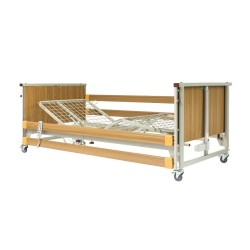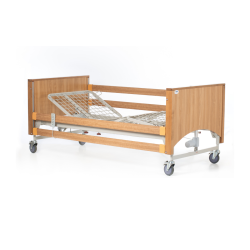Standard Profiling Beds
There are 3 products.
Active filters
About Standard Profiling Beds
Versatile Adjustable Beds for Comprehensive Patient Care
Standard profiling beds provide essential adjustable sleeping and care surfaces suitable for general patient populations across care homes, hospitals, rehabilitation facilities, and home care environments throughout England, Scotland, Wales, and Northern Ireland. These fundamental care beds feature electrically operated sections enabling backrest elevation, leg raising, and height adjustment supporting varied patient needs whilst remaining appropriate for users with typical body dimensions and standard care requirements. Care environments rely on standard profiling beds for general ward patients requiring adjustable positioning, care home residents needing routine care support, post-operative patients during recovery, rehabilitation patients progressing towards discharge, and individuals requiring temporary bed-based care. Modern standard profiling beds incorporate features including robust construction supporting typical patient weights usually up to 200-220kg safe working load, quiet electric actuators preventing sleep disturbance, variable height adjustment facilitating safe transfers and care delivery, four-section profiling enabling backrest and leg elevation, and lockable castors ensuring bed stability. The provision of appropriate standard profiling beds demonstrates commitment to patient comfort and safety through adjustable positioning, supports care delivery through appropriate bed height, and enables comprehensive care for general patient populations across professional care environments.
The implementation of standard profiling beds directly supports CQC compliance through enhanced patient safety, comfort provision, and demonstration of appropriate equipment provision meeting general care needs. Standard profiling beds serve the majority of care home residents and hospital patients, providing essential functionality without specialist features required only for specific populations. These beds address typical patient needs by enabling pressure relief through position variation, facilitating safe transfers through height adjustment, supporting respiratory function through backrest elevation, enhancing comfort through adjustable positioning, and enabling dignified care delivery through appropriate bed height. Clinical applications include general hospital ward use for medical and surgical patients, care home provision for residents with standard mobility and care needs, rehabilitation supporting progressive mobilisation, post-operative care enabling comfortable positioning, and temporary care during illness or recovery. Care organisations benefit from standard profiling beds through cost-effective provision meeting majority needs, reliable functionality supporting daily care delivery, regulatory compliance meeting general bed standards, and appropriate specification avoiding over-specification costs. Modern standard profiling beds incorporate features such as integrated side rail options, central locking systems, and mattress platform designs accommodating various pressure-relieving mattresses throughout England, Scotland, Wales, and Northern Ireland.
Selecting and implementing standard profiling beds requires assessment of patient populations, appropriate specification, and integration with care delivery protocols across care facilities throughout the UK. Organisations should evaluate typical patient characteristics ensuring standard beds meet majority needs, assess care requirements determining necessary bed functionality, consider environmental factors including space and electrical supply, and calculate bed quantities based on bed numbers and planned procurement. Bed selection should prioritise appropriate safe working load typically 200-220kg for general populations, four-section profiling providing backrest and leg elevation, variable height adjustment typically 300-700mm floor to bed deck, robust construction ensuring longevity, and compatibility with standard pressure-relieving mattresses. Implementation protocols must encompass comprehensive staff training on bed operation including control handset use, safety feature management, emergency lowering procedures, and appropriate positioning for different care scenarios. Quality assurance measures should include planned maintenance schedules ensuring continued functionality and safety, monitoring of bed-related incidents, regular bed checks verifying mechanical safety, and documentation demonstrating appropriate equipment management. Modern standard profiling beds may incorporate features such as nurse call integration, patient exit alarms, and antimicrobial coatings. Organisations should establish bed management systems tracking beds and maintenance, determine protocols for bed allocation, and integrate beds with falls prevention and pressure injury prevention strategies. Clinical teams should understand appropriate bed positioning, safe working load limitations, and recognition when patients require specialist beds. Staff education should address bed operation, safety features, cleaning protocols, and incident reporting. By implementing appropriate standard profiling beds and professional management protocols, care organisations throughout England, Scotland, Wales, and Northern Ireland demonstrate their commitment to CQC standards, patient safety and comfort through adjustable bed provision, staff safety through appropriate bed height, and responsible equipment procurement providing appropriate beds meeting general patient needs across mainstream care environments.



